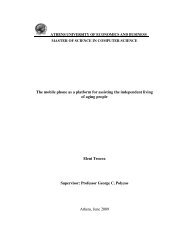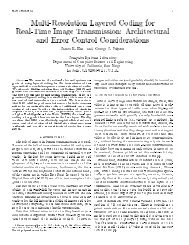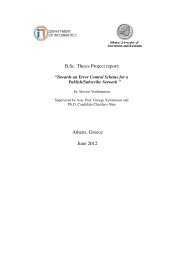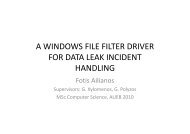In Network Processing and Data Aggregation in
In Network Processing and Data Aggregation in
In Network Processing and Data Aggregation in
You also want an ePaper? Increase the reach of your titles
YUMPU automatically turns print PDFs into web optimized ePapers that Google loves.
2. Less packet collisions.Packet collisions occur more frequently when the network is veryloaded. Less transferred packets is translated <strong>in</strong>to less packetcollisions.3. Less redundant read<strong>in</strong>gs.<strong>In</strong> the case of Direct Delivery, where all the <strong>in</strong>dividual read<strong>in</strong>gs aredelivered separately to the host node, it is a common phenomenonthat a node sends its values to multiple parents. This results <strong>in</strong>reception of the same packet multiple times by the s<strong>in</strong>k. <strong>In</strong> dataaggregation, the filters drop the redundant packets (cach<strong>in</strong>g is used).4. <strong>In</strong>crease <strong>in</strong> accuracy of results.If a sensor node is temporarily down, its parent can estimate avirtual value based on node’s previous read<strong>in</strong>gs. Thus the totalaggregate value is not significantly affected. Of course, this benefitholds <strong>in</strong> slow-chang<strong>in</strong>g environments.3.2 Query <strong>Process<strong>in</strong>g</strong>A user can send queries to the sensor network, <strong>in</strong> order to retrieve <strong>in</strong>formation aboutits state. The query is usually <strong>in</strong>jected <strong>in</strong>to the network from specific nodes (e.g. s<strong>in</strong>k or agateway). There are several proposed approaches for syntax of a query, its lifetime, itsscope, its propagation <strong>and</strong> f<strong>in</strong>ally its parametrization.<strong>In</strong> Directed diffusion [3] the queries are formed as “<strong>in</strong>terests” which are expressionswith multiple attribute-value pairs (Figure 10). Predef<strong>in</strong>ed attribute categories <strong>and</strong>subcategories <strong>and</strong> application specific data representation characterize <strong>in</strong>terests. Usuallydata are also named <strong>in</strong> a similar way <strong>and</strong> so, the application filters are able to performdata aggregation.<strong>In</strong>terest message Exampletype = wheeled vehicle<strong>in</strong>terval = 20 ms // send events every 20 msduration = 10 s // for the next 10 srect = [-100; 100; 200; 400] // from sensors with<strong>in</strong> rectangle.Figure 10








